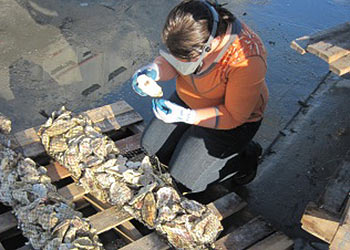 The Shellfish Health Laboratory (SHL) at BML is the State Department of Fish and Wildlife’s shellfish health facility and is also a UCD Vet Med lab through the Principal Investigator, Colleen Burge. Findings from the SHL have been critical to the State of California and these include:
The Shellfish Health Laboratory (SHL) at BML is the State Department of Fish and Wildlife’s shellfish health facility and is also a UCD Vet Med lab through the Principal Investigator, Colleen Burge. Findings from the SHL have been critical to the State of California and these include:
- Demonstrating the susceptibility of red abalone at San Miguel Island to disease-induced mortality during El Nino events. An experimental commercial fishery is being considered for this population and the study results can be incorporated into fishery design models.
- Showed that green abalone are resistant to the disease withering syndrome, and are therefore a good species on which to focus recovery efforts for abalone in the southern California bight.
- Tracked the northerly spread of the agent of abalone withering syndrome into populations subject to the red abalone recreational fishery.
- Monitored the health of captive populations of the federal ESA-listed white abalone that are being held for use in the species’ recovery program.
- Developed an oxytetracycline antibiotic delivery method that is capable of completely eliminating the agent of abalone withering syndrome in captive abalone populations being used in species recovery programs. We then successfully used this method to treat captive populations of the endangered white abalone being held at four facilities located throughout California, including BML.
- Demonstrated the success of the eradication effort for an introduced sabellid polychaete worm among intertidal snail populations near the outfall of an abalone farm. The non-native worm had become established in the snail population in the early 1990s and eradication was attempted in 1996 via removal of infected snails. We demonstrated the success of that effort by showing its absence for nine consecutive years of sampling.
- Certified four abalone holding facilities as free of the sabellid polychaete, allowing them to participate in outplanting efforts for abalone recovery programs.
- Determined patterns of colonization, growth, reproduction and pathogen presence in native oysters settled onto mounds of oyster shell experimentally outplanted in San Francisco Bay.
- Examined over 1300 samples from waterbodies from throughout California for the presence of planktonic larval stages of invasive quagga and zebra freshwater mussels.
- Determined that planktonic larval stages of the quagga mussel can survive for more than five days in single droplets of water, demonstrating the risk of transfer of the species between waterbodies with the movement of recreational vessels.
- Continued our ongoing role in regulating shellfish importations and transfers for aquaculture and research purposes.
